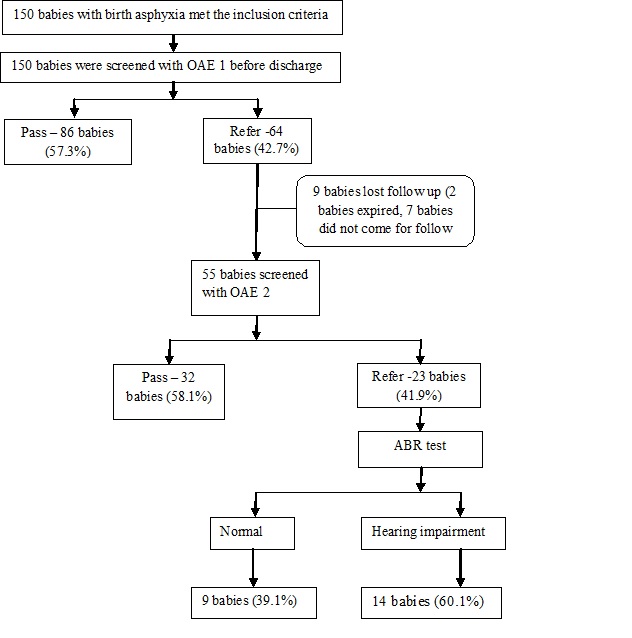A study on prevalence of hearing impairment in newborns with birth asphyxia admitted to neonatal intensive care unit
Abstract
Background:Hearing is a vital part of a newborn’s contact with his environment. Consequences of perinatal asphyxia range from death to various degrees of neuro-developmental sensory or motor deficits. One of its well-known sequelae is sensorineural hearing impairment. Hence this study was undertaken to find the prevalence of hearing impairment in inborn neonates with birth asphyxia.
Methods: Prospective Observational study was conducted to assess the prevalence of hearing loss in neonates with birth asphyxia admitted to the NICU at KIMS, Hubballi, Karnataka, India, from January 2015 to December 2015. Auditory function was examined by Otoacoustic emission (OAE) followed by auditory brainstem response (ABR) test and distortion product OAE (DPOAE). Statistical analysis, Chi-square test was used and testing data was analysed using the SPSS software version 22.
Results: Among the 150 neonates, prevalence of hearing impairment among term neonates with birth asphyxia was 9.9% (14/141). Babies with severe birth asphyxia (P=0.00037), hypoxic ischemic encephalopathy (P=0.00914), convulsions (P=0.0093) and those who were mechanically ventilated (P=0.0003) were more prone to develop hearing impairment.
Conclusions: The prevalence of hearing impairment among term neonates with birth asphyxia was 9.9% (14/141). Two staged screening with OAE, which is a feasible screening test in resource poor set up, can be used as a screening modality for hearing impairment in babies with birth asphyxia.
Downloads
References
2. Beatriz CW. Parents of deaf children. In Prabhakar E,Claudia K, Sian T, editors. Listening to Sounds and Signs: Trends in Deaf Education and Communication. 1st ed. Bangalore, Chrostoffel Blinden Mission and Books for change; 1988:14.
3. Norton SJ. Application of transient evoked otoacoustic emissions to pediatric populations. Ear Hear. 1993 Feb;14(1):64-73.[pubmed]
4. Paramar B, Patel V, Gohil CS, Patel A, Chaudhari S, Ardeshana D. A Clinical Study of Hearing Screening with OAE in 300 Highrisk Newborns. Global journal for research analysis. Sep 2014; 3(9):83-8. doi: 10.15373/22778160.
5. Pourarian S, Khademi B, Pishva N, et al. Prevalence of hearing loss in newborns admitted to neonatal intensive care unit. Iran J Otorhinolaryngol. 2012 Summer;24(68):129-34.[pubmed]
6. Bahl R. Newborn and infant hearing screening.In: Ivo Kocur, editor.Current issues and guiding principles for action. Geneva. WHO Press; 2010.
7. World Health Organization (WHO). Situation review and update on deafness, hearing loss and intervention programs proposed plans of action for prevention and alleviation of hearing impairment in countries of the South East Asia Region. New Delhi WHO Regional Office for South East Asia; 2007.
8. WHO South East Asia Regional Neonatal-Perinatal Database Report 2007-2008. New Delhi, India: World Health Organization Regional Office for South-East Asia (SEARO); 2008.
9. Joint Committee on Infant Hearing; American Academy of Audiology; American Academy of Pediatrics; et al. Year 2000 position statement: principles and guidelines for early hearing detection and intervention programs. Joint Committee on Infant Hearing, American Academy of Audiology, American Academy of Pediatrics, American Speech-Language-Hearing Association, and Directors of Speech and Hearing Programs in State Health and Welfare Agencies. Pediatrics. 2000 Oct;106(4):798-817.
10. Lakshmi T, Zaheera Sultana S, Brid SV. Brainstem Auditory Evoked Potentials in Birth Asphyxia Infants. J of Evolution of Med and Dent Sci. Oct 2014; 3(49):11749-11754. doi: 10.14260/jemds/2014/3543
11. Aseel Al-Meqbel, Hamad Al-Baghli. The prevalence of hearing in high-risk Infants in Kuwait. Aud Vest Res. 2015;24(1):11-16.
12. Gouri ZU, Sharma D, Berwal PK, et al. Hearing impairment and its risk factors by newborn screening in north-western India. Matern Health Neonatol Perinatol. 2015 Jul 6;1:17. doi: 10.1186/s40748-015-0018-1. eCollection 2015.
13. Patel R, Goyani R, Patel D. Hearing Impairment and its Correlates among Newborns at Tertiary Care Hospital of Surat. Ntl J of Community Med. Oct – Dec 2015; 6(4):629-632.
14. Binay C, Kavuncuoglu S, Fidan V, Binay O, Altuncu E, Taskin U. Screening for Abnormal Hearing in Newborns and Assessment of High-Risk Group. Austin J Otolaryngol. 2016; 3(2): 1073.
15. Nagapoornima P, Ramesh A; Srilakshmi, et al. Universal hearing screening. Indian J Pediatr. 2007 Jun;74(6):545-9.[pubmed]
16. Misra PK, Katiyar CP, Kapoor RK, et al. Brainstem auditory evoked response in neonates with birth asphyxia. Indian Pediatr. 1997 Mar;34(3):199-205.[pubmed]
17. Rout N, Parveen S, Chattopadhyay D, et al. Risk factors of hearing impairment in Indian children: a retrospective case-file study. Int J Rehabil Res. 2008 Dec;31(4):293-6. doi: 10.1097/MRR.0b013e3283007dc9.[pubmed]
18. Lim G, Fortaleza K. Overcoming challenges in newborn hearing screening. J Perinatol. 2000 Dec;20(8 Pt 2):S138-42.[pubmed]
19. Early Identification of Hearing Impairment in Infants and Young Children. NIH Consens Statement. 1993 Mar 1-3;11(1):1-24..
20. Yoshinaga-Itano C. Early intervention after universal neonatal hearing screening: impact on outcomes. Ment Retard Dev Disabil Res Rev. 2003;9(4):252-66. DOI:10.1002/mrdd.10088.[pubmed]
21. Baradaranfar M, Mehrparvar A, Mostagahci M, Mollasadeghi A, Naghshineh E, Davari M. Hearing Abnormality in Neonate Intensive Care Unit (NICU),Yazd-Iran. International Journal of Pediatrics, Apr 2014; 2(2.2): 113-117. doi: 10.22038/ijp.2014.2345.

Copyright (c) 2019 Author (s). Published by Siddharth Health Research and Social Welfare Society

This work is licensed under a Creative Commons Attribution 4.0 International License.


 OAI - Open Archives Initiative
OAI - Open Archives Initiative


